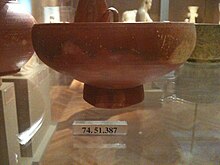Eastern sigillata A
In 1957, Kathleen Kenyon introduced categories A, B, C, to classify eastern sigillata without determining the exact place of manufacture.
[1] For ESA, still no production centers have been identified but distribution patterns suggest an origin in northern Syria.
ESA is distinguished by the fineness of its fabric, which stands out as very pale in comparison to the deep red-slip that usually covers all surfaces.
Early forms develop in the context of an eastern Mediterranean Hellenistic Koine Greek, while later products are influenced by trends originating in Italian workshops.
Many ESA forms are mold-made and exhibit distinct delineation between walls and floors as well as elegantly curved exterior and base profiles.

